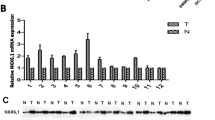Abstract
Background
ZEB1, a member of the ZFH family of proteins (zinc-finger E-box binding homeobox), plays a central role in epithelial–mesenchymal transition (EMT) during carcinogenesis. In this study, we investigated the expression of ZEB1 in patients with hepatocellular carcinoma (HCC) and its clinical effects with underlying mechanisms.
Methods
Expression levels of ZEB1 were assessed by Western blot in 5 HCC cell lines and in paired cancerous and noncancerous tissues from 110 patients with HCC. Short-hairpin RNA (shRNA) interference for ZEB1 was performed in MHCC-97H cell line.
Results
ZEB1 protein was detected at a relatively high level in metastatic human HCC cell lines (MHCC-97L and MHCC-97H) when compared with that in nonmetastatic HCC cell lines (Hep3B, PLC and Huh-7). ZEB1 was expressed at high levels in 72 of 110 HCC patients (65.4%) and correlated with advanced TNM stage, tumor size >5 cm, intrahepatic metastasis, vascular invasion, and frequent early recurrence. The results of multivariate analysis revealed that ZEB1 high expression was a significant prognostic factor for poor overall and disease-free survivals. Silencing ZEB1 resulted in significant suppression of motility of MHCC-97H cell line, which was accompanied with increased expression of the epithelial marker E-cadherin and decreased expression of the mesenchymal markers N-cadherin and vimentin. Furthermore, silencing ZEB1 prevented the spread of intrahepatic metastasis and increased overall survival in mouse orthotopic tumor models.
Conclusions
This study shows that ZEB1 high expression was correlated with HCC malignant progression and subsequent poor patient survival by induction of EMT changes.




Similar content being viewed by others

References
El-Serag HB, Rudolph KL. Hepatocellular carcinoma: epidemiology and molecular carcinogenesis. Gastroenterology. 2007;132:2557–76.
Lau WY, Lai EC. Hepatocellular carcinoma: current management and recent advances. Hepatobiliary Pancreat Dis Int. 2008;7:237–57.
Waldmann J, Feldmann G, Slater EP, et al. Expression of the zinc-finger transcription factor Snail in adrenocortical carcinoma is associated with decreased survival. Br J Cancer. 2008;99:1900–7.
Iwatsuki M, Mimori K, Yokobori T, et al. Epithelial-mesenchymal transition in cancer development and its clinical significance. Cancer Sci. 2010;101:293–9.
Eger A, Aigner K, Sonderegger S, et al. DeltaEF1 is a transcriptional repressor of E-cadherin and regulates epithelial plasticity in breast cancer cells. Oncogene. 2005;24:2375–85.
Spoelstra NS, Manning NG, Higashi Y, et al. The transcription factor ZEB1 is aberrantly expressed in aggressive uterine cancers. Cancer Res. 2006;66:3893–902.
Spaderna S, Schmalhofer O, Hlubek F, et al. A transient, EMT-linked loss of basement membranes indicates metastasis and poor survival in colorectal cancer. Gastroenterology. 2006;131:830–40.
Spaderna S, Schmalhofer O, Wahlbuhl M, et al. The transcriptional repressor ZEB1 promotes metastasis and loss of cell polarity in cancer. Cancer Res. 2008;68:537–44.
Singh M, Spoelstra NS, Jean A, et al. ZEB1 expression in type I vs type II endometrial cancers: a marker of aggressive disease. Mod Pathol. 2008;21:912–23.
Graham TR, Zhau HE, Odero-Marah VA, et al. Insulin-like growth factor-I-dependent up-regulation of ZEB1 drives epithelial-to-mesenchymal transition in human prostate cancer cells. Cancer Res. 2008;68:2479–88.
Drake JM, Strohbehn G, Bair TB, et al. ZEB1 enhances transendothelial migration and represses the epithelial phenotype of prostate cancer cells. Mol Biol Cell. 2009;20:2207–17.
Takeyama Y, Sato M, Horio M, et al. Knockdown of ZEB1, a master epithelial-to-mesenchymal transition (EMT) gene, suppresses anchorage-independent cell growth of lung cancer cells. Cancer Lett. 2010;296:216–24.
Li Y, Tang ZY, Ye SL, et al. Establishment of cell clones with different metastatic potential from the metastatic hepatocellular carcinoma cell line MHCC97. World J Gastroenterol. 2001;7:630–6.
Lu W, Dong J, Huang Z, et al. Comparison of four current staging systems for Chinese patients with hepatocellular carcinoma undergoing curative resection: Okuda, CLIP, TNM and CUPI. J Gastroenterol Hepatol. 2008;23:1874–8.
Poon RT, Fan ST, Ng IO, et al. Different risk factors and prognosis for early and late intrahepatic recurrence after resection of hepatocellular carcinoma. Cancer. 2000;89:500–7.
Xia HH, Zhang ST, Lam SK, et al. Expression of macrophage migration inhibitory factor in esophageal squamous cell carcinoma and effects of bile acids and NSAIDs. Carcinogenesis. 2005;26:11–5.
Lee TK, Poon RT, Yuen AP, et al. Twist overexpression correlates with hepatocellular carcinoma metastasis through induction of epithelial-mesenchymal transition. Clin Cancer Res. 2006;12:5369–76.
Huang MT, Wei PL, Liu JJ, et al. Knockdown of thrombomodulin enhances HCC cell migration through increase of ZEB1 and decrease of E-cadherin gene expression. Ann Surg Oncol. 2010;17:3379–85.
Smith GE, Darling DS. Combination of a zinc finger and homeodomain required for protein-interaction. Mol Biol Rep. 2003;30:199–206.
Higashi Y, Moribe H, Takagi T, et al. Impairment of T cell development in deltaEF1 mutant mice. J Exp Med. 1997;185:1467–79.
Takagi T, Moribe H, Kondoh H, et al. DeltaEF1, a zinc finger and homeodomain transcription factor, is required for skeleton patterning in multiple lineages. Development. 1998;125:21–31.
Murray D, Precht P, Balakir R, et al.The transcription factor deltaEF1 is inversely expressed with type II collagen mRNA and can repress Col2a1 promoter activity in transfected chondrocytes. J Biol Chem. 2000;275:3610–8.
Yen G, Croci A, Dowling A, et al. Developmental and functional evidence of a role for Zfhep in neural cell development. Brain Res Mol Brain Res. 2001;96:59–67.
Peinado H, Olmeda D, Cano A. Snail, Zeb and bHLH factors in tumour progression: an alliance against the epithelial phenotype? Nat Rev Cancer. 2007;7:415–28.
Zhou Y, Sui C, Li B, et al. Repeat hepatectomy for recurrent hepatocellular carcinoma: a local experience and a systematic review. World J Surg Oncol. 2010;8:55.
Zhou YM, Yang JM, Li B, et al. Risk factors for early recurrence of small hepatocellular carcinoma after curative resection. Hepatobiliary Pancreat Dis Int. 2010;9:33–7.
Acknowledgment
Supported by Foundation of Xiamen Science and Technology Bureau (3502Z20084010), China National Key Projects for Infectious Disease (2008ZX10002-021) and the National Natural Science Foundation of China (30772513).
Author information
Authors and Affiliations
Corresponding author
Additional information
Yan-Ming Zhou and Lu Cao contributed equally to this study.
Rights and permissions
About this article
Cite this article
Zhou, YM., Cao, L., Li, B. et al. Clinicopathological Significance of ZEB1 Protein in Patients with Hepatocellular Carcinoma. Ann Surg Oncol 19, 1700–1706 (2012). https://doi.org/10.1245/s10434-011-1772-6
Received:
Published:
Issue Date:
DOI: https://doi.org/10.1245/s10434-011-1772-6



